#Fender Bass VI
Text
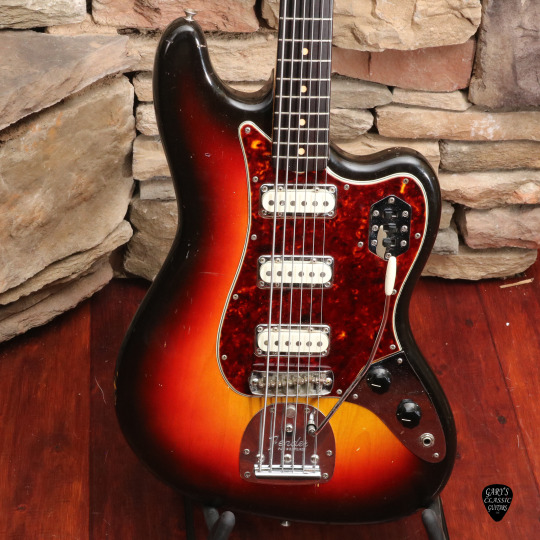
Sold: 1961 Fender Bass VI....super early example.
27 notes
·
View notes
Photo
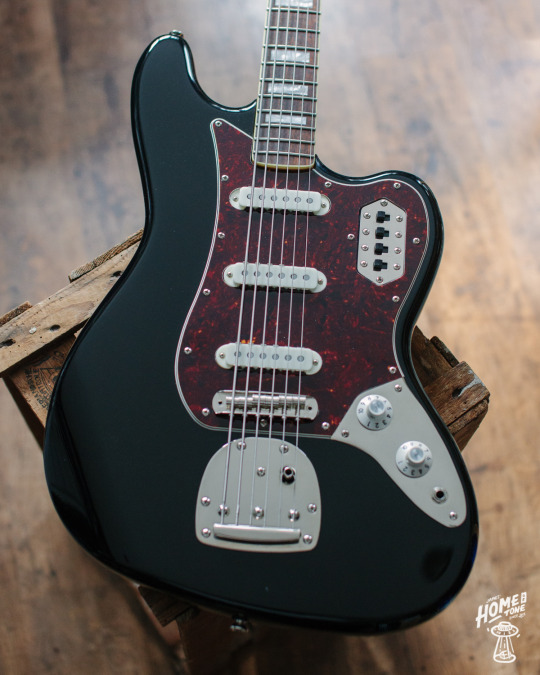


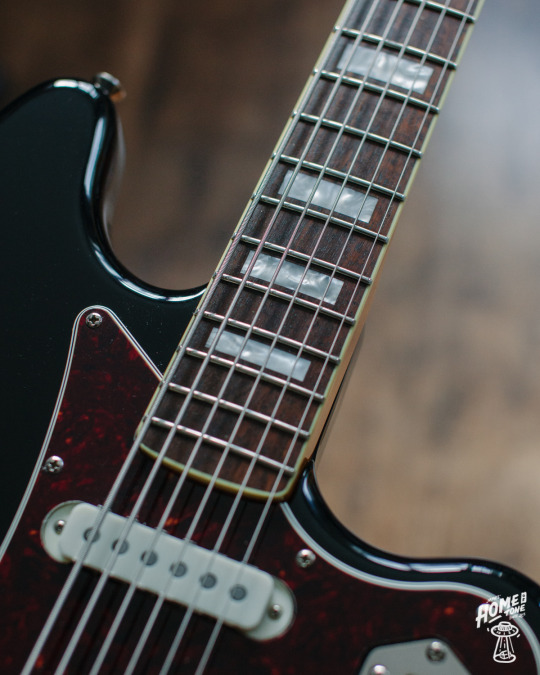


Squier Bass VI finished up this week for a customer. Setup on the Stringjoy Signatures ‘Balanced Medium’ Bass VI string set, huge transformation in play-ability over the factory strings and setup.
#Bass VI#Squier#squier guitar#squier guitars#Squier bass#bass guitar#Squier Bass VI#Fender Bass VI#Stringjoy#guitars#home of tone
19 notes
·
View notes
Text

I’m using this Hooky Bass VI on a song I’ve written for a future Unwed Sailor record. I love the way it sounds.
6 notes
·
View notes
Text
Y'know, I don't get the whole "guitar or bass" thing. It feels like a Splatfest that's been going on for decades at this point.
If we're being totally honest, I think that you should be allowed to play what you wanna play, and if you wanna play both, then play both.
Now, I'm not saying to go all Mike Rutherford, and make a double-neck guitar with a bass. One, that's a little overboard, and two, someone already beat you to the punch.
What I mean is more like "play what you want, when you want, I'm not stopping you," because if I can get ideas about buying and playing this thing...

...who am I to judge about you playing guitar like a bass or vice versa. Bring some of your playstyle to it!
Now, does this mean I'm abandoning the Telecaster Bass VI? No. I've not abandoned a build project yet, and I'm not starting with the bass. It might get delayed, sure. The Fretless is currently in for refinishing, and I've just started back at college again.
But other than that? I think we're still on track for the TB6 to be the next project. And then, who knows, maybe I'll actually do a scratch build. That'd be a fun thing to take up the next 2 years.
#okay which one am i on now#let's see#takosader's ramblings... eight? i think?#that means i've hit the octopus number#in which case#yippee!!!#also what the hell is going on in squier#who thought up the jazz bass vi#who said yes to it#i want to meet them and shake them warmly by the hand#guitar building#squier guitars#fender guitars#fender jazz bass
1 note
·
View note
Text

A semi-recent pic with one of my coolest and most unique instruments, my Squier Bass VI - yes, it’s a bass lol, guitar like as it may look ☺️
#bass guitar#squier vi#fender#bassist#music#doc martens#flat cap#beard#alternative#alleyway#me#personal
1 note
·
View note
Text
Holy crap!
I got a Fender VI~ish copy, in lefty.

1 note
·
View note
Text
At dawn i had a dream that i saw the Cure play live in a goth club (there was a large bat-shaped ornament on the ceiling), they were early 80s Cure and played 3 imaginary boys and a forest, but also a mostly instrumental song that was sooooo beautiful and i'm not sure whether it exists, if it does it's probs a b-side. Can't recall it any more tho the dream was vivid. Robert also played a 5-string bass (not a fender vi; don't think this is real either)
3 notes
·
View notes
Photo

Time for a mini re-write of Fender’s Bass VI history: According to the folks at Fender, there was a 20 year gap between the end of the Bass VI’s original USA production run and the first Fender Japan reissues in 1995. Enter the Custom Edition Bass VI, a rebranding of Fender Japan’s Custom Shop made-to-order ExTrad line. This one was produced in 1992 (!) with pot codes from Feb ‘92 and all hangtags. Even has a “Custom Edution” branded gigbag; something I’ve never seen (has to be a pretty special day to get excited about a gigbag). #Fender #BassVI #offsetguitars #FenderJapan #CustomShop (at Mike & Mike's Guitar Bar) https://www.instagram.com/p/CqL6G4cPJqL/?igshid=NGJjMDIxMWI=
33 notes
·
View notes
Text

... sound of rebellion ...
1964 Gibson SG "The Fool" Eric Clapton's guitar and 1962 Fender bass VI Jack Bruce's guitar (Cream)
youtube
Happy heavenly birthday Jack Bruce
Remembering Jack Bruce who was born on May 14, 1943
#jack bruce#happy heavenly birthday#the cream#sound of rebellion#famous guitars#i feel free#blast your music#listen out loud#Youtube
6 notes
·
View notes
Text
Bass VIにクラシックなレスポールタイプのブリッジを付ける
JazzmasterやJaguar系のブリッジをレスポールタイプのブリッジにガチでちゃんと交換する話です。

Bass VIはFender JazzmasterやJaguarと同じタイプのブリッジを採用しているのですが、このタイプのブリッジは比較的お手軽にレスポールで採用されているTune-o-maticタイプのブリッジに交換できる、という話を以前書きました。
しかし、あくまでこちらはお手軽にできるというだけの話で、現実的には弦高が高く、さらに弦高調整もできないという問題がありました。ということで、今回は本格的に気合を入れてブリッジを交換してみます。
なお、Bass VIはギターなのかベースなのかという議論がありますが、以下はJazzmaster/Jaguarと共通の話なので、今回は便宜上ギターと表記しています。
Tune-o-maticタイプのブリッジの種類
レスポールで使われているTune-o-maticタイプのブリッジには、ブリッジ本体の穴が大きいものと小さいものの2種類があります。以前使ったものは穴が大きいタイプで、これはギター本体にネジ受けが付いた杭のようなもの(スタッド)を打ち込んで、そこに弦高調整をできるようにネジが切られた棒(ポスト)をねじ込んでその上にブリッジを設置する、という構造になります。GOTOHの製品だとGE103B-Tというのがこのタイプですね。スタッドの径(つまりギター側に開ける穴の径)は11.3mm、ポストのネジはM8、ブリッジ本体の穴とその間隔はそれぞれ6.5mm、74mmです。
いっぽう、穴が小さいタイプのほうは、ポストを直接ギター本体に打ち込んで、そこに高さ調整用の円盤状のナット(ホイール)を取り付けたうえでその上にブリッジを設置します。GOTOHの製品ではGE103Bというやつがこちらになります。ポストの径は4mm、ブリッジ本体の穴とその間隔はそれぞれ4.5mm、74mmです。
ちなみにJazzmaster/Jaguarタイプのブリッジはスタッドの径が9mm、その間隔は73mmです(参考情報)。そのため、Tune-o-maticタイプのスタッドを打ち込もうとする場合、ギター本体側の穴を大きくする加工が必要になります。一方、ポストを直接打ち込むタイプのTune-o-maticブリッジであれば、もともとのスタッド部分に棒を打ち込んだうえで、そこに約4mmの穴をあけてポストをねじ込むことで、ギター本体にダメージを与えずにTune-o-maticタイプのブリッジを取り付けることができるはずです。
ブリッジの調達
ということで、まずはおなじみ千石電商でブリッジを調達します。ネット通販サイトには掲載されていないのですが、店頭にはさまざまなTune-o-maticタイプのブリッジが多数並べられています。今回はひとまず実験的な作業ということで、ノーブランド(SUNG IL)の安いやつを買ってきました。

ちなみにこの穴が小さいサイズのブリッジ、こんな感じで長いナットに挿すと実はJazzmaster/Jaguarタイプのスタッドに直接はめ込むことができたりします(が、やはり弦高調整に難がある)。
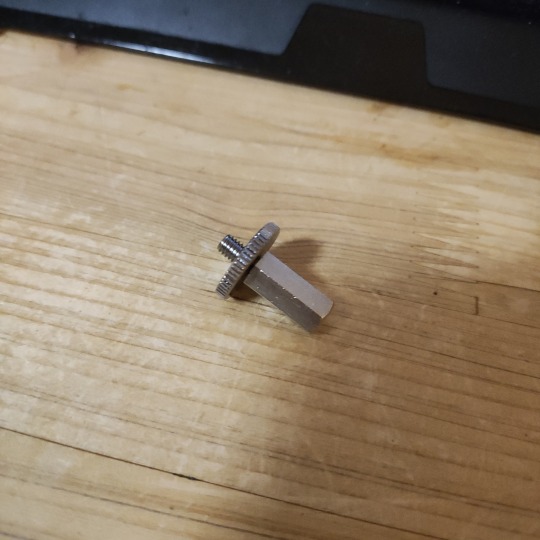
丸棒の調達
また、ブリッジ穴に打ち込む棒の調達も必要です。しかし、木工の世界では直径9mmの丸棒というのは珍しいものらしく、近所のホームセンターを数軒回ったのですが見つけられませんでした。いきなり計画がとん挫……するかに見えたのですが、コーナンの通販サイトで見つけることができました。コーナンの通販サイトは在庫のある店舗も検索できるという素晴らしさ。ということで、在庫のあったドイト後楽園店に電車に乗って行って買ってきました。ホームセンター、行ってみないと欲しいものがあるか分からないことが多いのでとても助かります。なんの木材なのか一切素性は謎ですがそこは目をつむりましょう。
(追記:新宿のハンズにはなかったのですが、ふらっと渋谷のハンズによったら置いてありました。さすが基幹店。)
丸棒の加工
続いてこの丸棒の加工です。元々のJazzmaster/Jaguarタイプのスタッドは長さが約20mmなのですが、ギター側の穴の深さを測ったところそれよりも若干長かったため、まずは22mmほどの長さに丸棒をカットします。これに関しては適当なのこぎりで気持ち長めにカットして、やすりで整えるだけなので簡単です。問題は、ここにポストをねじ込む穴を開ける作業です。ギター側のスタッド固定用の穴は73mm間隔ですが、取り付けるブリッジの穴の間隔は74mmなので、丸棒の中心から0.5mmずれた位置に穴を開ける必要があります。人間の手でそのような加工が可能なのでしょうか……?
ということで、正確に穴開けおよびカットができるレーザー加工機でこんな感じの治具を作りました。
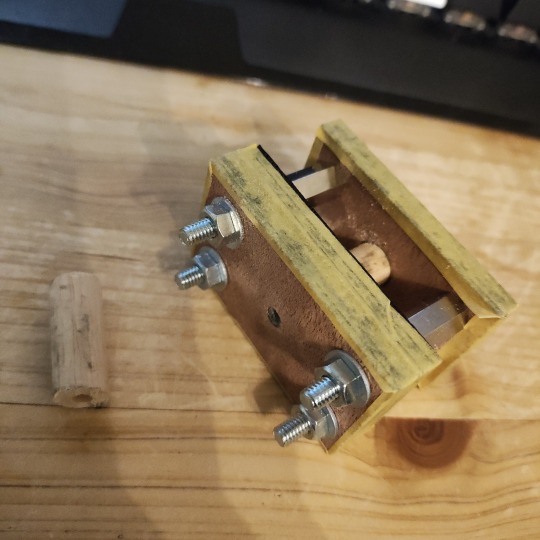

治具の下側には9mmの穴が、上側にはその中心から0.5mmズレた場所に約4mmの穴が開いており、下から9mm棒を挿し込み、その状態で上の4mm穴にドリルを突っ込んで穴開けをすると、中心から0.5mmズレた場所に約4mmの穴が開く、という仕組みです。ちなみに約4mmと書いてきましたが、実際にはそれより少し小さい径(約3.2mm)の穴を開けて、そのあとタップでネジを切る作業をやっています。あと、棒の直径が実際には正確に9mmではなく、楕円状に少し太い感じになっていたため、穴開け後に手作業でやすり掛けして径を整える作業もしています(これが地味につらかった)。
丸棒を叩き込む
丸棒の加工が完成したら、ポストをねじ込んだ状態で軽くスタッド穴に挿し込み、その状態でブリッジを乗せてポストの位置を調整します。

位置が決まったら、いったんブリッジとポストを外し、ゴムハンマー的なもので棒を叩き込みます。

こんな感じで、ポストをねじ込む穴が丸棒の中心からずれていることが分かるかと思います。
あとは再度ポストをねじ込んでブリッジを乗せて組み上げれば完成です。
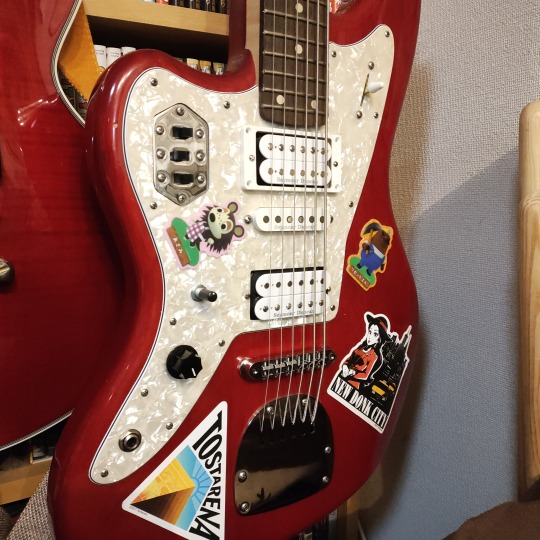
ポストを直接ギター本体にねじ込むことで、ブリッジの高さをギター本体に接触するレベルまで下げられるようになりました。Bass VIは指板の高さが低くRも大きいため、これでかなり弾きやすくなりました。これはテイルピースも固定タイプにしていますが、ローラータイプのブリッジを乗せればオリジナルのビブラート対応テールピースでも使えそうです。
2 notes
·
View notes
Photo






Fender Custom Shop Bass VI Journeyman Relic - Aged Sherwood Green Meta – Lark Guitars
9 notes
·
View notes
Text
So, What Next?
Yeah, the title says everything: what's next in my adventures with guitar? Well, there's a few ideas on the table.
And by "a few", I mean "I've got 5 total ideas and they're all fighting for dominance." I wish that were false, but here we are.
So, let's list each one, front to back.
Fender Marauder build
Attempting to recreate John Lennon's modded Les Paul Jr. from a kit
Gretsch Country Gentleman build
Telecaster Bass VI build
Getting (and subsequently modding) an Epiphone Casino.
To fuck with logic and sensibility, let's go from the bottom and work our way up. Also, warning to everyone: this is going to be a VERY long post.
Epiphone Casino mod
You might recognise the Epiphone Casino from when I talked about my first project on here: the Fretless Stratocaster (which I'm hoping to refinish at some point).
The Casino is what I wanted to work with originally as a kit, instead of the Strat that I ended up using. However, I discovered something: you can't actually get a thinline hollow-body guitar as a kit because it's likely (not 100% on this) too niche of an interest for a first - or second-time builder.
This, as you could probably guess, was a massive disappointment to 16-year-old me, but now, 2 years later, I've kinda stopped with the whole "kitbash" thing. I know I listed the LPJr. kit build above, but that's gonna be a hell of a thing to do. More on that later.
Anyway, why would I buy instead of build in this case? To answer that, we need to talk about parallel universes the feasibility of making a fully hollow guitar, from scratch. Also capitalism.
So, what does building a hollow-body guitar actually entail? Well, I'm glad you asked, dear reader, because, as it turns out, quite a hell of a lot goes into building one. First, you have to have a veneer press. Yes, seriously. Why? Because you'll never get a solid top on a guitar that looks like this:

Now, this isn't to say that there aren't solid-top electric semi/fully hollow guitars out there. I'd venture to guess that Höfner do a bunch, just because they do both violins and guitars & basses. In fact, I know the Violin Bass (500/1 my beloved) has a solid spruce top, just because I've spent way too much time checking Thomann to see what they have in stock. But that's neither here nor there.
The Casino has a 5-ply maple body. Yes, five. That's 5 sheets of wood for the top, sides and back, which are pressed into formation to make the Casino. If I remember correctly, the top is made of a veneer sandwich of maple and poplar. I could be wrong, or I could be thinking of what Gibson have done. Either one is possible.
Anyway, where does capitalism come into this? It comes in when you ask "How much would all of this cost?" The short answer is "more than it'd be worth to do it." Not only do you have to find how to press veneers together in such a way that you can make the arched (yes, the top is pressed into its arch, it's not carved out) top, but you also have to source the equipment required to do so, and the veneers themselves. It's way too much hassle, money, and general effort for what would generally be a one-off build.
So that's why I'm not approaching the Casino from the angle of building it. Now, onto what I'd actually do to the thing.
Y'ever wonder why Gibson/Epiphone never stuck a PAF in the ES-330/Casino? I have! There's no definite answer to the question, sadly. In my personal opinion, I think it's because they were too scared to try it. It could, just as easily, be that they tried that, and came to the conclusion that it just didn't work, but I personally prefer the idea that it's the former, because Gibson haven't done shit in terms of new stuff. And before you reply with "What about the Theodore," may I remind you that that was stuffed in McCarty's desk for a reason (that being that it's fucking ugly jfc Gibson).
But yeah, this is the main plan: get a Casino, take out the old P90s, and put something like these things in there. Best part, the dogear covers are curved for such use!
Okay, Moving On.
The Telecaster Bass VI
This one is slightly more unique than the Casino build.
So, you remember the Cherry Telecaster XII build? Yeah, the one that required the use of a separate guitar body. I haven't got rid of that original body. It's still sat, waiting to be used. So, what's the plan?
I have some spare parts that I was so graciously given, including a set of tuning machines, a set of Telecaster pickups, ash-tray and saddles. These will all get used in the process of building the TB6. But you might be wondering - what about the neck?
Y'see, the interesting thing about this is that I want to gain experience in building guitars, not just cobbling together kits and calling it a day. I want to learn how to make a guitar from scratch. Part of that, in turn, means learning how to cut and shape a neck, and how to actually do frets.
This is where the kitbashing was supposed to end. However, I got kinda invested in the whole Lennon Les Paul Jr. thing, and that's my hard cutoff point in this case. I hope.
But enough about that, what does this actually entail?
The build entails constructing a neck from scratch, mainly, and modding the remaining pieces in order to smoothly fit the spare parts. That's it.
There's also the deal about finishes, personal touches and all that funk, jazz, and funky jazz, but the main thing to keep in mind is that this is kinda a one-off, and I'll most likely make shit up as I go. That's why this section is so much shorter than the previous one.
Next on the list...
Gretsch Country Gentleman build
This one is a shelved build, but still on the list.
The Gretsch Country Gentleman (numbered as the G6122 by Gretsch) is the signature model of guitar for the late Chet Atkins, one of the most famous American country guitarists of the mid-to-late 1950s.
It also costs, brand new, US$3,499. As much as I like the sound of the guitar, I don't want to even touch that price point, because JESUS CHRIST that's expensive. So what's the next best thing? Why, building it, of course?
Here, we run into the same issue as with the Casino: materials and methods being really expensive. But where the Casino costs less than a grand, this costs US$3,499. In this case, it's worth it.
The Country Gentleman has more documentation, as well as features, so let's run through those:
Bigsby B6 vibrato tailpiece
2 Filter'Trons (TV Jones Classics, in this case)
Mudswitch
Pickup selector
Standby switch
Flip-up foam mutes
Roller bridge for added tuning stability
ElectroTone body (thinline chambered hollow body)
Zero fret
Grover Imperial tuners
For a non-guitar nerd, that might sound weird. Let me break it further down.
The mudswitch has 3 options: no tone circuit factored in (bright as can be), ~9 on a tone knob, and ~5 on a tone knob; the standby switch cuts the signal from the guitar when you don't want your guitar making noise (like in between songs on a live set); the flip-up mutes allow the simulation of palm muting while not needing your hand to constantly rest on the bridge.
As for the rest of the features, they're not exactly important, and also, did I mention that this was a shelved project? The whole reason is that there's a little too much required work for right now.
Next!
Attempting to Recreate John Lennon's Les Paul Junior from a kit
This one is far easier, because most of the leg-work is already done for me.
Firstly, there was a recreation of his Junior back in 2007, done by Gibson themselves, so I can at least take from that to recreate it to my tastes. Secondly, I've a kit to bash this out of, so I can do most of the work without worrying about the rest of the guitar.
One small issue, however - this is the real thing:

Image source: https://www.mattsguitar.shop/en/vendues/gibson-custom-les-paul-junior-john-lennon
Now, you may be wondering, "Hey, um, what the fuck's that pickup in the neck?" That, my friend, is a recreation of the first electric pickup Gibson ever made: the Charlie Christian pickup.
It's technically the ES-150 pickup, designed in 1936, and gaining its common name through the wholesale adoption by famous jazz and bebop guitarist Charlie Christian. Sit back, folks, this one's a doozy.
The original pickups were built using 2 cobalt steel bar magnets, as AlNiCo magnets weren't widespread knowledge at the time, and were used to not only hold the pickup together, but also keep it attached to the top of the guitar. Remember, this was Gibson's first electric pickup, the P90 wouldn't be invented for another 10 years.
They were also wound with an incredibly thick gauge of wire: 38awg. In comparison, modern pickups are wound with either 42 or 43awg. It's not like extreme wire gauges weren't common at the time - Rickenbacker were using 53awg for their pickups for a long while. The only reason they stopped is because they hand-wound their pickups, and 53awg is such an incredibly thin wire, it's prone to breaking with incredible ease.
Anyway, because the pickup uses such large magnets and large wire coils, it's actually rather inefficient. Due to this, it only averaged out a DC resistance of 2.5-4k Ohms, with examples of 1.1-1.5k Ohms being very common.
Now, that's all fine, nor is it my issue. My issue is with the pickup that was used, because he somehow found a lefty pickup??? and he put it in the neck position upside down?????
Okay that needs explaining. How do I know it's a lefty pickup? Because it has this little notch where it'd pass under the B string. You'll find the same sorta thing on a Strat pickup, the pole under the B string is much lower than the others. But the thing about this is that the gap just... goes under the A string instead??? Either John got real lucky, or he asked Gibson to make him one. And either way, I cannot find one that could replicate that, which is why this build is an attempt at a replica.
Okay, last, but CERTAINLY not least.
Fender Marauder build
This one is much less of a doozy than the pickup and the Les Paul Junior. Let's dive in.
First, I need to explain one concept - the offset guitar body. Leo Fender, by all measures, was Fucking Insane by guitar standards. In a good way, that is. He designed the Fender company's biggest guitars just on the concept of improving through feedback. Take the Stratocaster for example: that was designed based on the feedback of wanting:
a vibrato system that could do what the Bigsby could, then return to tuning with ease.
individually adjustable saddles.
a more comfortable body than the slab of the Telecaster.
That's where the Strat came from, but where'd Leo get the idea for this thing, then?

In short, it was Leo getting further into the whole "improvements" thing. Larger pickups for a more defined response, a lead/rhythm circuit that emphasised an individual pickup in the switching, with which the volume and tone became pickup-specific, and a vibrato that was, in theory, easier to use and produce, meaning no need for back routing.
And y'know, he didn't get rid of everything from the Strat. He kept the body contours, the individually adjustible saddles, but he made one interesting change: the body wasn't aligned anymore. Notice the parts where the body curves inwards, around the waist of the guitar. That's the offset.
And, to his credit, the Jazzmaster was the first example of the offset guitar, with the biggest competitor (Gibson) not making a response until 5 years later, in 1963. Their response, being the Thunderbird bass and Firebird guitar, were the first example of a reverse offset, where the lower half of the guitar is more prominent than the upper half.

It was also designed by Ray Dietrich if you're wondering why it looks so off for a guitar. It's barely even offset!
So anyway, the Jazzmaster was the first of many offsets that Fender produced. There was also the:
Jazz Bass
Jaguar
Bass VI
Mustang
Electric XII
Marauder
Now, most of these have become mainstays of the Fender/Squier line-up over the years, except for that last one - the Marauder. Why? Because the Marauder never saw full production, and all the prototypes ended up going into the personal collection of Quilla "Porky" Freeman. A few have appeared here and there since then, but the model never got its time in the limelight.
Oh, sure there was the Modern Player Marauder back in 2010, but good golly gosh, wouldn't you believe it, that got none of the unique features!
Let's compare what it could have been to what it ended up as.
The Type II (2 different images because of the different headstocks)...


And the Modern Player.

Yeah, it's not exactly a competition between them in terms of features. It got done dirty with the reisue.
In case you're confused:
The Marauder was to have individual 3-mode pickup switching, but got shafted with this 5-way blade switch
Planned to have a Mustang vibrato, but got a 6-screw Strat-style trem. I know the Type 1 prototype had the Strat-style trem, but come on, you could stand to at least give it something more unique.
Was to have a lead/rhythm circuit and a standby/kill switch, and got neither one.
Yeah, the Modern Player Marauder holds nary a candle to the prototypes.
So what's my plans for this build? There's many things in my head related to this, from finish and colour to what I'm going to make it with to whether or not I want to make this kinda Red Special-ish with a zero fret and a floating tremolo, or just use a Mustang vibrato.
I do, however, know what I want to do with the pickups! I have a third pickup from the person who gave me the pair of Telecaster pickups, a hot-rodded Broadcaster bridge pickup, which you can probably guess where that's going. However, what about the other 2 pickups?
As the middle pickup, I was thinking a Burns Tri-Sonic (the same pickup as the Red Special), but I'm not sure on the neck pickup. Maybe a Wide-Range Humbucker? Or maybe a PAF copy? It's a series of long and hard thoughts in this case.
So yeah, that's everything! Keep in mind that this is always subject to change. You'd be surprised what goes on in my head to do stuff like this.
#takosader's ramblings lucky seven#fender guitars#gibson guitars#epiphone#gretsch#good lord what is happening in there#“there” being my brain#wow this is a long post#surely i won't regret posting this#john lennon#guitar building#lutherie#i wish most of this was a joke#it really isn't#okay that's enough tags
4 notes
·
View notes
Photo

Just arrived a 1974 Fender Bass VI-Electric 6 String Bass Guitar in its original black tolex hard shell case! - Check it out by clicking the link in our profile. Thanks. (at Retrofret Vintage Guitars) https://www.instagram.com/p/CjntBThOqFk/?igshid=NGJjMDIxMWI=
16 notes
·
View notes
Text

This is the Ibanez EHB1005SMS.
That's a horrible name, but that breaks down to:
Ergonomic Headless Bass, 1000 series, 5-string, Short Multi-Scale.
Ibanez introduced the EHB series a few years ago, and at first I thought they were weird looking.
And then I started listening to demos and reading reviews.
This particular one is a "multi short scale" - the low B is 32" and the high G is 30" scale, so it's shorter scale overall, but gives the low B a longer scale for a tighter feel - low Bs on short scales tend to be flabby otherwise and it's hard to get strings for them.
youtube
That longer upper horn helps it balance really well; it's got a chambered body to reduce weight (it's about...7lbs??); everyone says the neck is super comfortable, and it definitely seems versatile sound-wise.
Seriously debating selling my two History basses and getting one of these. I should try one in a store first, though.
Now starting to see my collection as:
Two Fender mini-strats unless I sell one?
EHB1005SMS fretted bass
Future Bass VI / Hooky 6 style instrument for New Order-y stuff
Future EHB fretless conversion from the EHB1000S 4-string shortscale?
#Ibanez#ehb series#ergonomic headless bass#5-string bass#ehb1005sms#short scale#multi-scale#fanned fret#Youtube
2 notes
·
View notes

